

William Stopford
Every car discontinued in Australia in 2025
16 Hours Ago
The second-gen Golf R Wagon is faster and more practical, but it's also much dearer and the cabin is a little... drab. Is it worth $70k?
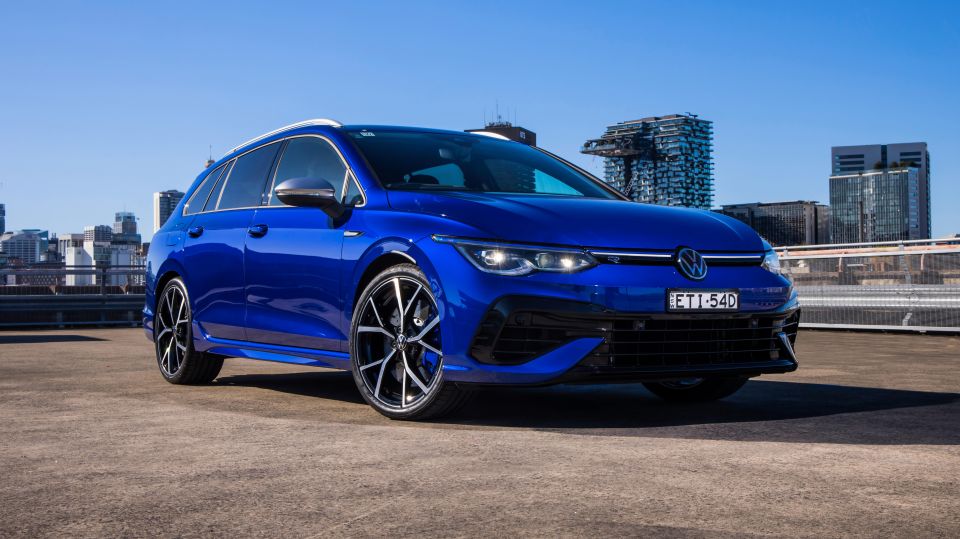
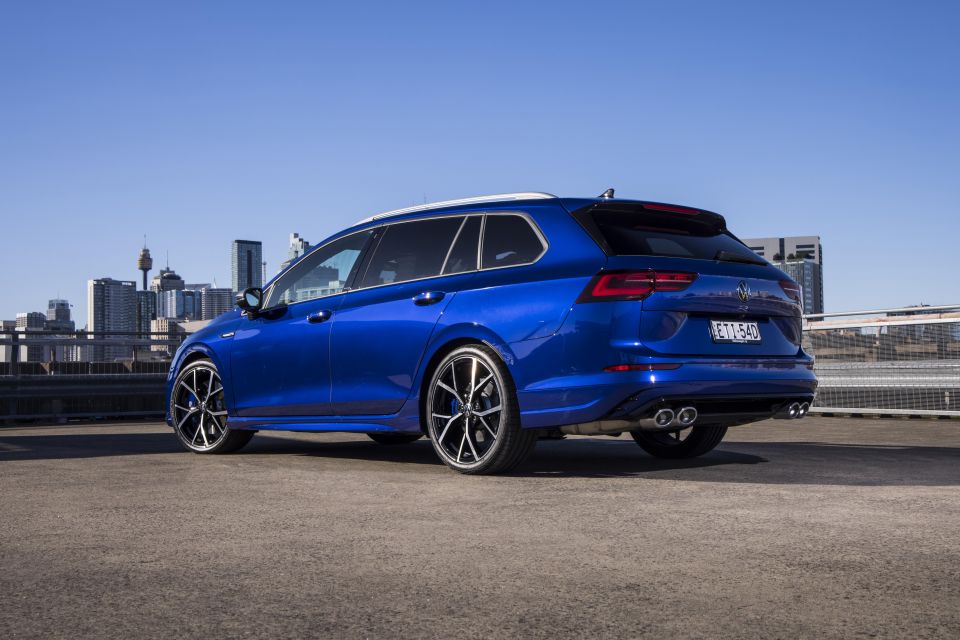

Quickly see how this car stacks up against its competition. Select any benchmark to see more details.
Where expert car reviews meet expert car buying – CarExpert gives you trusted advice, personalised service and real savings on your next new car.
The Volkswagen Golf R is often described as the ultimate daily, blending accessible, blistering performance with everyday drivability and practicality.
A hot hatchback does many things for many people, but a hot wagon? Now we’re talking.
Since its debut with the seventh-generation Golf family, the Volkswagen Golf R Wagon adds another dimension to the already capable foundations laid by its hatchback counterpart.
It’s got more boot and rear seat space, and arguably more street cred given wagons are something of a rare sight on Australian roads. If you know, you know…

Fast forward to 2022 and we have the Mk8 Golf R Wagon hitting showrooms.
It’s even more of an outlier given many manufacturers are moving away from compact wagons and passenger segments in general, and almost serves as a more budget-friendly Audi S4 Avant – at least on paper.
At $68,990 plus on-road costs, you’re basically spending Audi A4 Avant money on a Golf, albeit one with the heart of an Audi S3 as well as a features list as long as your arm. Identically priced also, is the Volkswagen Tiguan R with its more in-vogue SUV body.
With turbocharged go, all-wheel drive traction and European heritage, is this new Golf R Wagon good enough to justify its premium price tag?
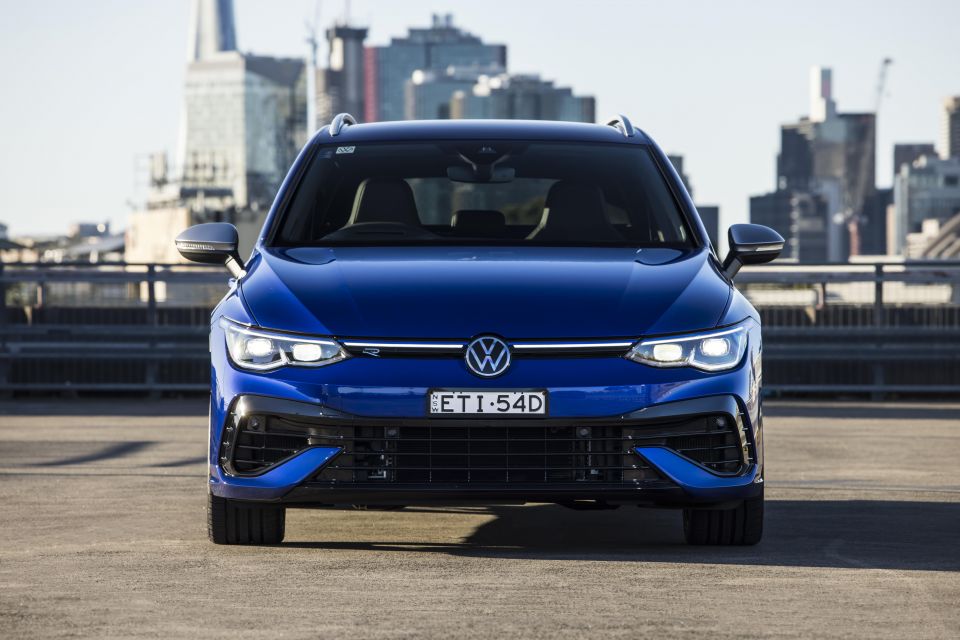
The Mk8 Golf R Wagon is priced from $68,990 before on-road costs, commanding a $3000 premium over the Golf R hatch and line-ball with the Tiguan R SUV. Our test car featured the optional harman/kardon premium audio system ($1000), bringing the as-tested price to $69,990 plus on-roads or just under $79,000 drive-away with a Melbourne postcode.
It’s a bit more than the old one, which listed for $57,990 plus on-roads when it was last on sale in 2020. The increase is equivalent to an $11,000 premium before on-road costs, and even more once you factor in drive-away pricing.
Thankfully, you are getting extra stuff for your extra spend. The new Golf Wagon is bigger, and more tech-laden than before. The new Golf R gets more power than before, and in wagon-bodied guise scores the full-fat European engine tune including a petrol particulate filter (PPF), something Australia hasn’t received previously.
More on the new inclusions and uprated engine in a bit, but regardless of how you look at it the Mk8 Golf R range in general is a substantial amount of money.
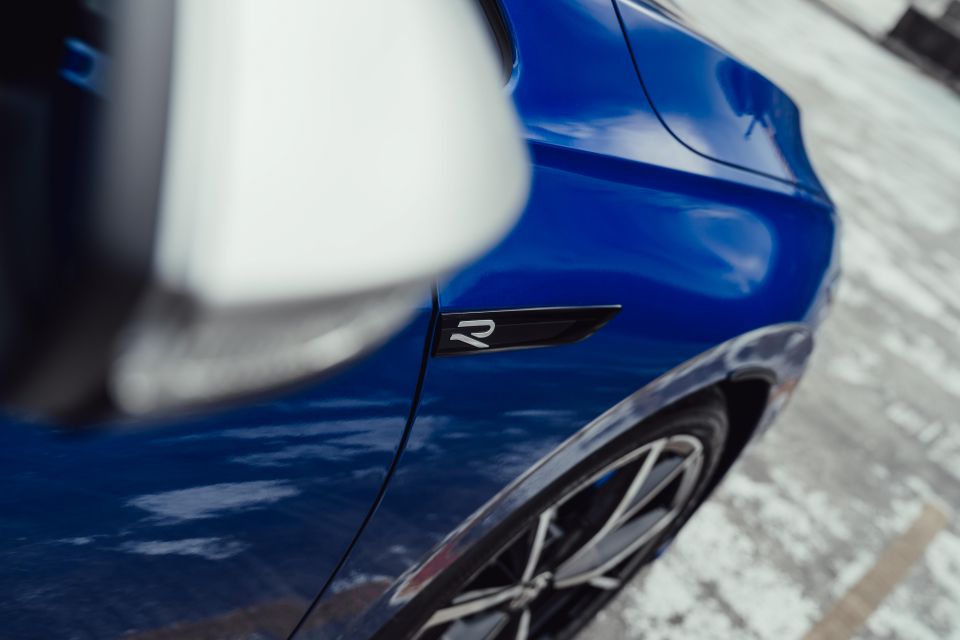
Key rivals include:
Prices exclude on-road costs unless specified
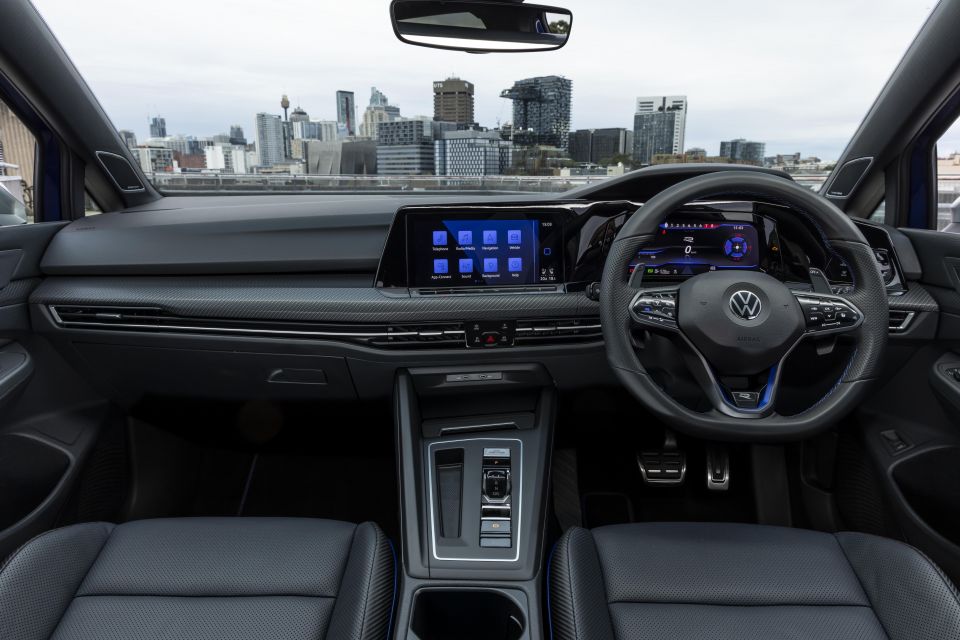
Buy your new car without the stress. It's fast, simple and completely free.

Great service from Travis and team, second time I have used this business would not hesitate to recommend them to anyone
Craig C.
Purchased a Ford Ranger in Sunshine Coast, QLD
CarExpert helped Craig save thousands on his Ford Ranger, now let us save you on your next new car.
Find a dealThere’s no denying that the new Golf has made big strides in terms of interior technology, with a stack of new features including a new-generation user interface, colour head-up display, and more configurability than ever. As a Mk7.5 Golf owner, however, it’s hard not to be critical of cabin elements which perhaps move away from what made previous Golf interiors so great.
While the big, high-resolution displays and clean lines look good at first glance, upon closer inspection the latest Golf cabin feels as though it’s fallen victim to cost-cutting.
A higher ratio of scratchy plastics, the bland colour scheme, fake carbon inserts, and big gloss black bezels around both displays make the new Golf feel like a dressed up cheap car.
It’s also missing things like the damped storage lid ahead of the shifter, sliding lid above the cupholders, and tactile switchgear that made the seventh-generation Golf one of the small car cabin benchmarks.
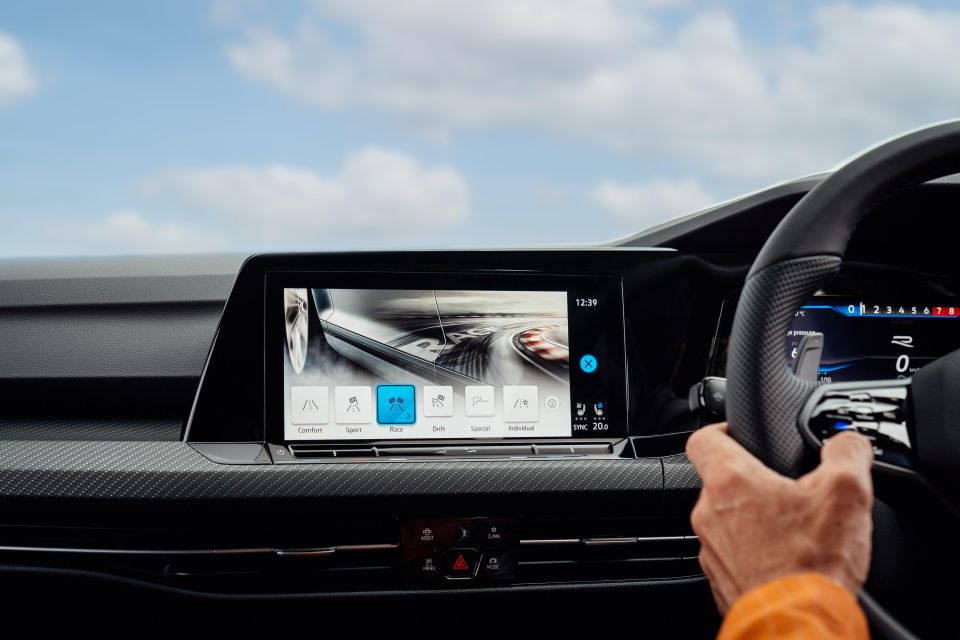

The ergonomics carry a bit of a learning curve, too. All the HVAC controls have been moved to touch-capacitive sliders and sub-menus in the 10-inch central infotainment system. It feels new and exciting when you use it in the showroom, but needing to change something on the go is fiddly and frustrating.
I found when using wireless Apple CarPlay – which was buggy to connect, but seamless from there – the location of the sidebar buttons often had me accidentally changing the temperature as the slider meets the corner of the display.
Speaking of the infotainment, the graphics are pretty sharp and load times are good, but there’s just a bit too much going on. While the newness makes it feel fresh, real-world operation reveals that usability and simplicity has taken a step back.
It’s a similar story for the 10.25-inch Digital Cockpit Pro display ahead of the driver, which is smaller than the 12.3-inch display in my Mk7.5 GTI and, like the infotainment system, feels different for the sake of it.
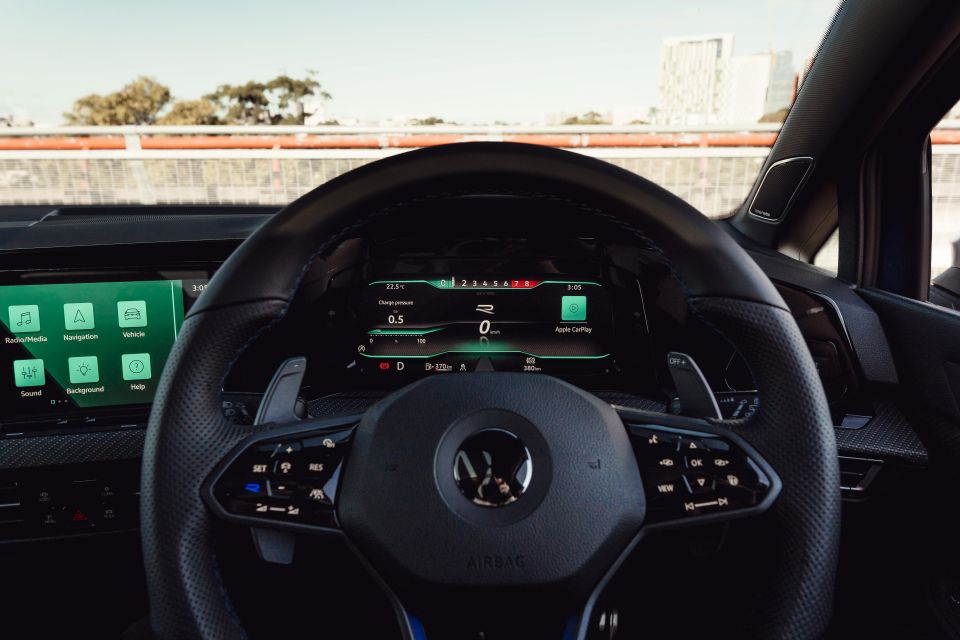
There’s a number of layouts, including a swish central rev dial as well as a racy skin that’s activated when you switch into one of the R modes, but it lacks polish. Flicking through the different layouts also means you have to reconfigure your two additional readouts on either side at times – which are toggled via the steering wheel.
Using the steering wheel can be a pain as well, with the touch-capacitive controls often mistaking a brushed finger for a push, and at times inaccurately recognising an input.
For example, holding the wheel at 3 and 9 o’clock in dynamic driving will have you accidentally pressing the drive mode or heated steering wheel buttons, or not pressing the voice command button in exactly the right spot will bring on the native assistant (short press) rather than Siri (long press).
I’d probably figure it out as an owner with ongoing use, but again it feels like usability has taken a backwards step here.

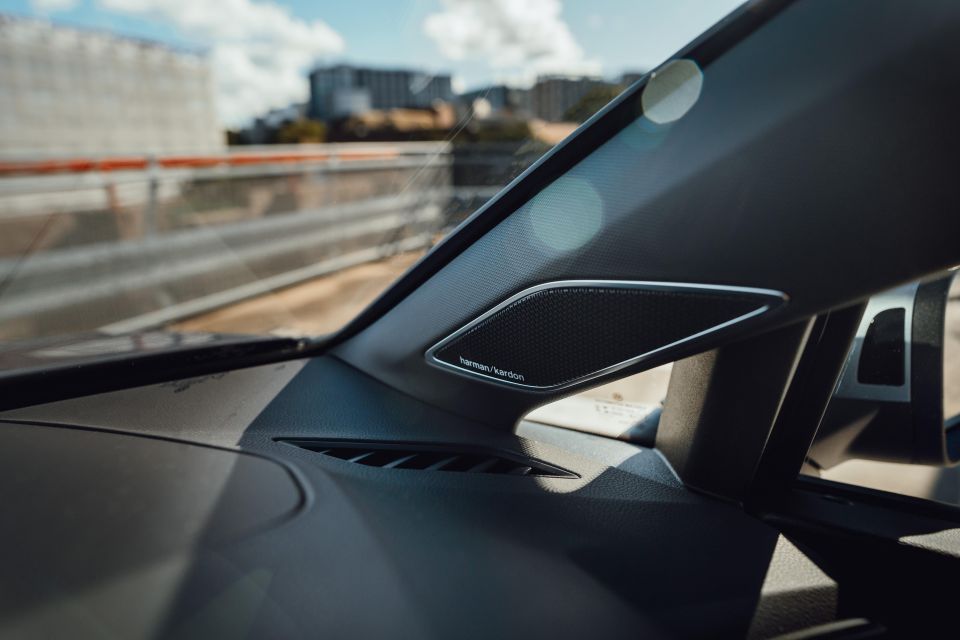
It’s not all negative, however.
Australian models come as standard with Nappa leather-trimmed R sports front seats, with integrated headrests and bucket-style bolstering, as well as blue embroidered R logos. They look the part, offer heaps of electric adjustment, feature two-position memory, and are also heated and ventilated.
There’s blue accents along the seatbacks as well as perforated inserts and carbon-look bolsters. It’s all quite sexy, and the seats themselves are really comfortable and well bolstered while allowing for various body types.
While the aforementioned touch-capacitive steering wheel controls can be fiddly, the steering wheel rim with its perforated side sections feels nice in the hand, with comfortable cutouts for your thumbs. It’s nice to hold, whether you’re driving to work or up a hillclimb. It’s also heated.
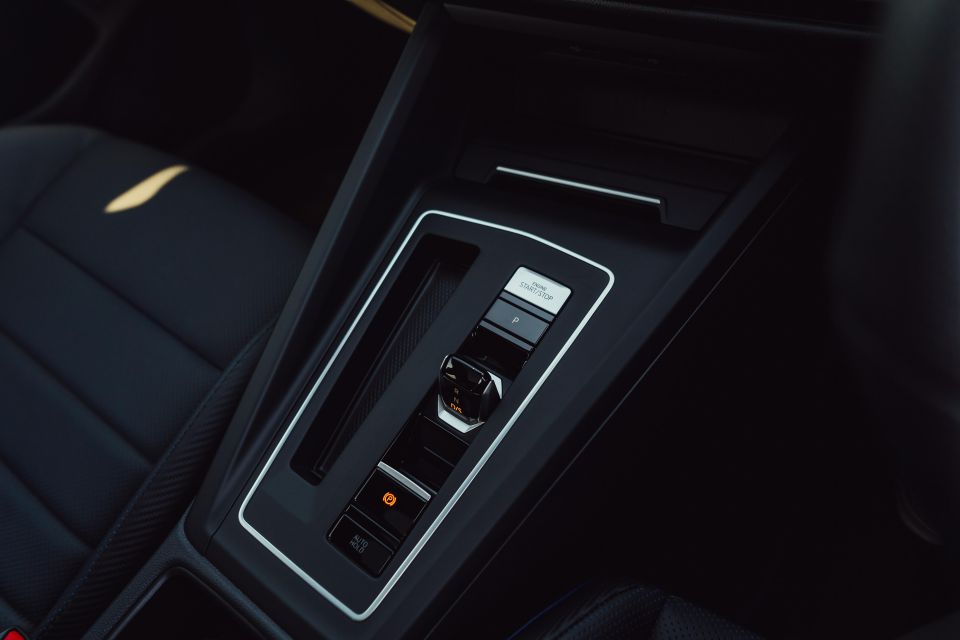
The somewhat bare centre console is a big departure from Golf generations past.
DSG versions of the Golf Mk8 get a stubby little e-shifter a-la the Porsche 911, and there’s a very pared back approach to switchgear and cubby lids here.
The slot next to the shifter seems to be made for the key, the thin lid ahead of the shifter hides a wireless smartphone charging pad, and on top of it there’s a grippy surface to keep your sunnies stowed.
A space between the front seats has an adjustable cupholder setup, but it doesn’t have a sliding cover like before and the slide out second cupholder rim feels a little… cheap. The cubby under the padded leatherette front-centre armrest is also quite small, but big enough for wallets, keys and the like.
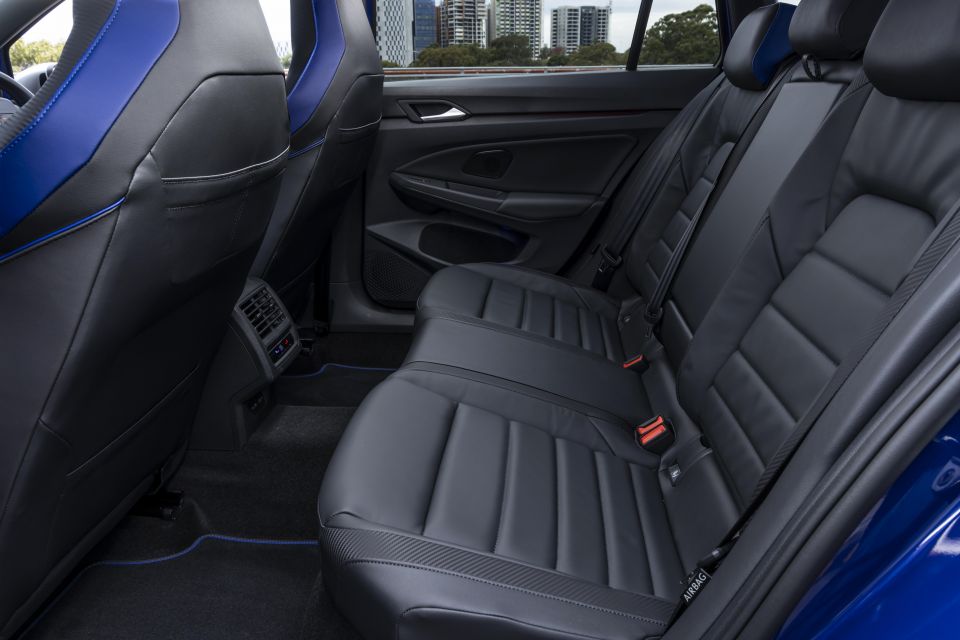
The Golf R Wagon adds 50mm of wheelbase over the hatchback, but as some tall CarExpert colleagues found, the rear-seat room isn’t as capacious as you might like.
At 6’1 I can sit behind my own driving position in decent comfort, but taller than tall Mike Costello and lanky Scott Collie struggled to fit comfortably back there without digging their knees into the seat in front.
It doesn’t help the R sports seats are much chunkier than the units in non-R Golf Wagon models, meaning the added length in the wheelbase is offset by the deeper seatbacks. The Tiguan R’s more standard-looking seats offer better rear passenger accommodation if you’re tossing up between the two vehicles.
Kids or shorter adults are well-catered for in the back, though. There’s a third zone of climate control, fold-down centre armrest with cupholders, flock-lined bottle holders in the doors to match the fronts, and two USB-C charge points at the rear of the centre console.
ISOFIX anchors on the outboard positions and top-tether points behind all three rear seats mean little ones are covered, too.
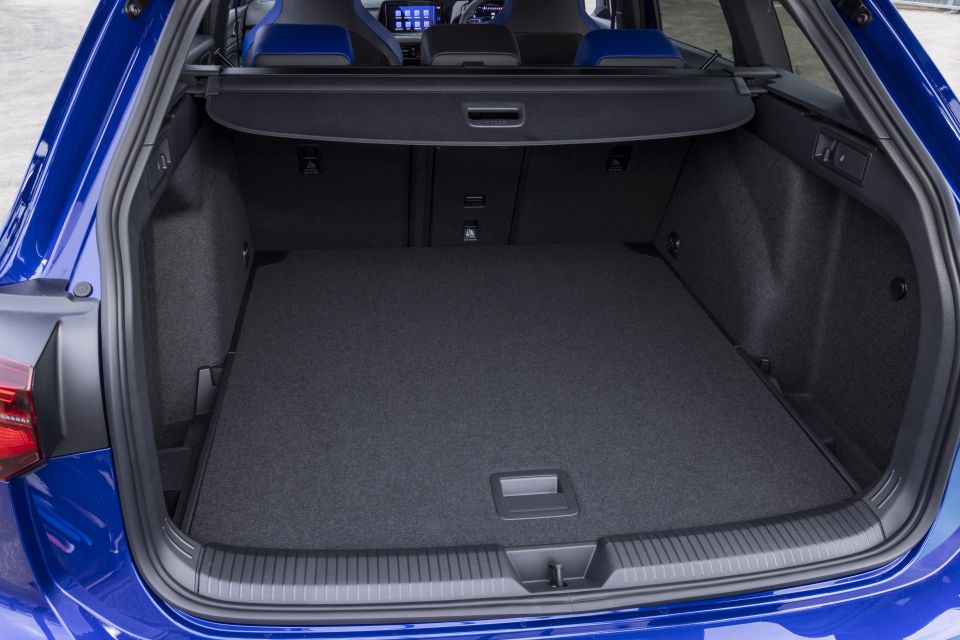
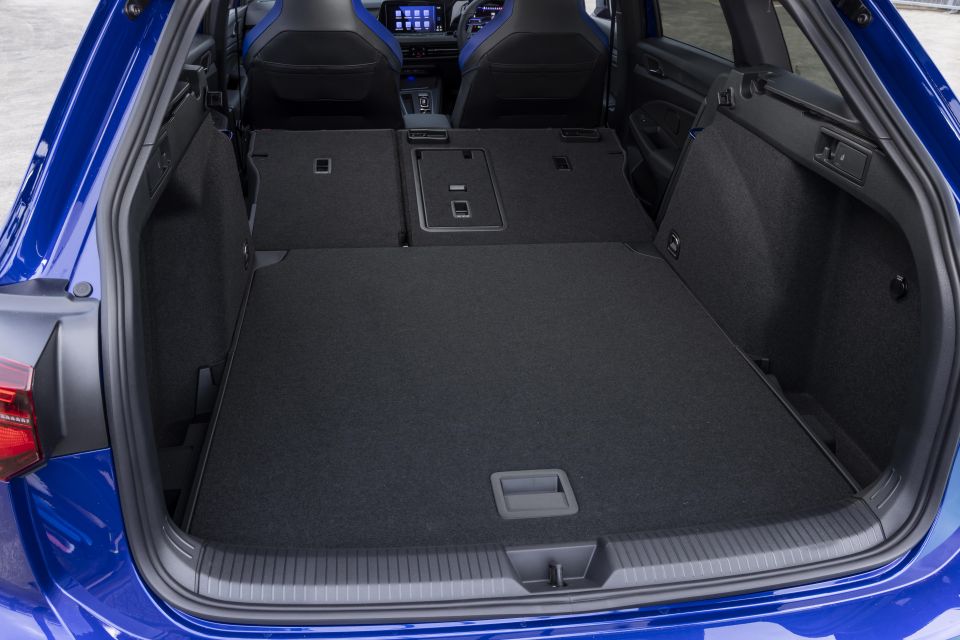
Arguably, the Golf R Wagon’s biggest trump card is the boot. It’s massive.
With a quoted 611 litres with the rear seats in place, the Golf R Wagon betters the hatchback by a significant 237L. The Tiguan R has up to 615L, but that’s with the rear seats slid forward – therefore the Golf R offers more volume than the SUV equivalent as well.
Drop the second row and the Golf R Wagon quotes 1642L of volume, 412L more than the R Hatch though 13L short of the Tiguan R.
There’s no spare wheel under that big boot floor, instead there’s a tyre mobility kit with sealant, and a 12V compressor to pump a punctured tyre back up.
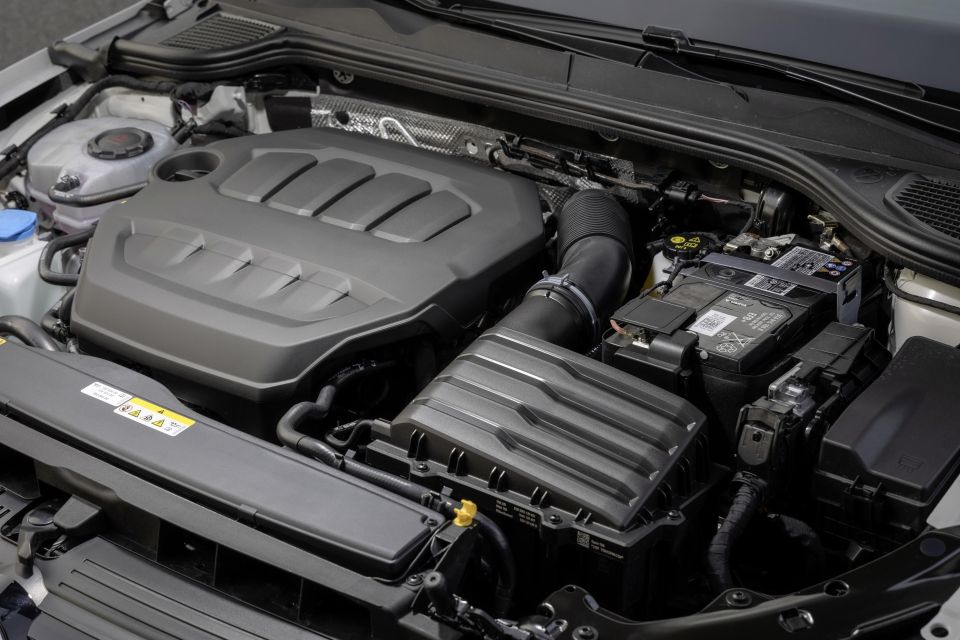
While the Golf R hatch and Tiguan R get a 400Nm version of the EA888 2.0-litre turbo four sans a petrol particulate filter (PPF), the Golf R Wagon runs the European-spec powertrain including a PPF in the exhaust.
That means the 2.0 TSI outputs 235kW (5200-6000rpm) and 420Nm (2000-5500rpm), sent to a 4Motion on-demand all-wheel drive system via a seven-speed DSG dual-clutch automatic.
Volkswagen claims the new Golf R Wagon can dash from 0-100km/h in 4.9 seconds, just 0.1s slower than the Australian-spec Golf R hatchback and 0.2s quicker than the Tiguan R. The 420Nm PPF-equipped engine should come soon to the Golf R and Tiguan R.
Thanks to its more sophisticated exhaust treatment system, the Golf R Wagon is more efficient than its hatchback sibling, with claimed combined fuel consumption of 7.4L/100km (v 7.8L/100km). Additionally, the PPF-equipped R Wagon emits less CO2, at 168g/km (v 177g/km).
Premium 98 RON unleaded is required, while the fuel tank capacity is rated at 55L – same as the hatch.
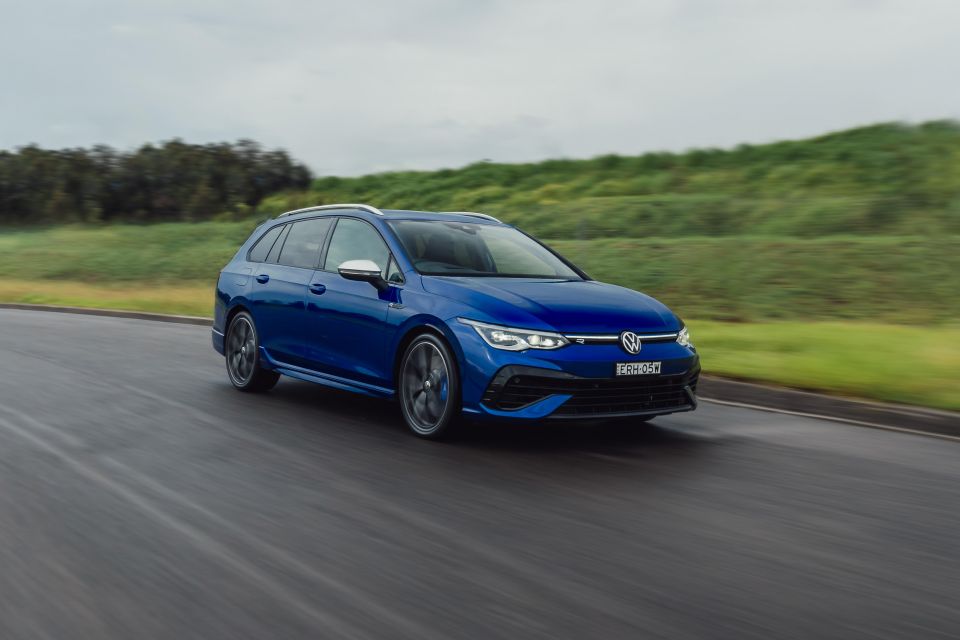
The new Golf R fires up with a raspy growl, and the low-slung driving position reminds you that this is no ordinary Golf Wagon.
Immediately I noticed that, while the engine note is somewhat synthesised in the cabin via the speakers, there’s a bit more accuracy to the tone in this Mk8 R. The Mk7 iterations in Race mode played an engine note through the speakers that sounded suspiciously like it was trying to imitate the five-cylinder note of an Audi RS3.
The Tiguan R plays a similar sound, so it was refreshing to have the latest Golf R amplifying the natural sound coming from the quad-tipped exhaust rather than trying to mask it. Shame there’s no Akrapovic titanium option…
Get moving and there’s a real level of refinement to the drivetrain. The quick-shifting seven-speed DSG is as smooth and intuitive as ever been in normal driving, and the effortless torque wave means putting around the ‘burbs is a cinch.
There’s 420Nm from just 2000rpm, which is diesel-like pulling power, and it helps the Golf R ride its meaty torque reserves in higher gears up inclines or off the line to aid efficiency. It’s pleasantly refined at a cruise, too.
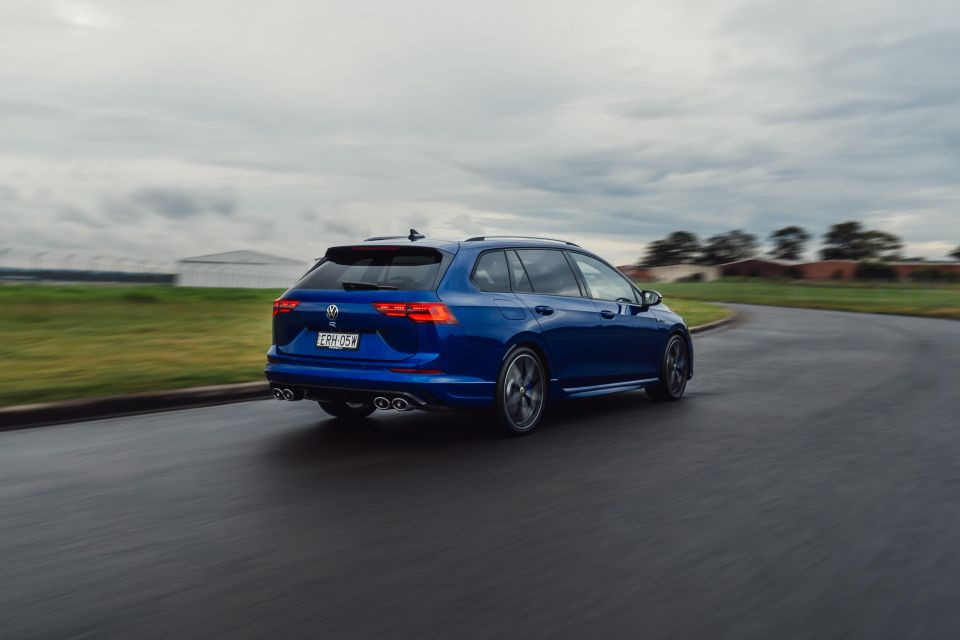
Where expert car reviews meet expert car buying – CarExpert gives you trusted advice, personalised service and real savings on your next new car.
Dial it up a little and the extra length of the Golf R Wagon doesn’t seem to impede its dynamic abilities. Straight-line pace is deceptively quick thanks to the linear acceleration response, and it feels as sharp and hunkered down as it’s ever been.
I took the R Wagon up through Victoria’s eastern hills to Kinglake, and there’s a mix of tight, twisty roads that when combined with the rain I had on the day, make for conditions that would make my GTI a little nervous. Not to worry, because the R ate it for breakfast.
There’s a sense of sure-footedness and security across all road surfaces in all conditions, and the vehicle feels more planted than the previous car. The quick steering (though not the last word in feedback) means you can accurately place the Golf R Wagon in tight, technical successive bends, and the amount of grip from the sticky 235/35 Hankook tyres and tricky differentials mean this thing feels unstoppable in the wet.
You can actually feel the 4Motion all-wheel drive system shuffling torque between the axles as well as the inside and outside wheels. It’s so quick that you never feel like the mechanicals are merely reacting and catching you before you fall – something I’ve felt in the likes of the BMW M135i xDrive. It feels proactive.
Even with the long bottom of the wagon, the Golf R turns in quickly and sharply, and rotates as if it’s a much smaller vehicle. I was surprised how much speed I could carry through the bends without upsetting the balance, and power out of each corner with confidence in the wet.
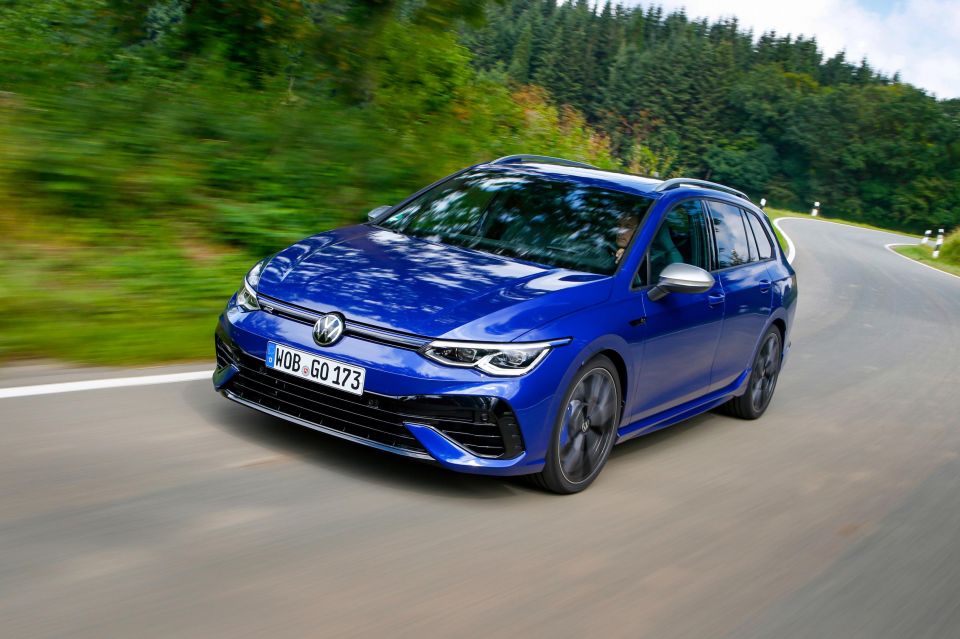
I kept it in Nurburgring mode, which combines the full-attack configuration of Race with a softer suspension designed to better tackle the lumpy surfaces of the Nordschleife. On the pimpled roads leading to Kinglake, this configuration felt just about perfect.
The adaptive chassis control in its softer tune absorbs imperfections admirably while also keeping the body tight in a very sporting manner. I also found the braking performance to be confidence-inspiring given the conditions, and Tony Crawford has previously mentioned the Golf R’s impressive brake performance on track.
Comfort doesn’t have quite the softness an everyday compliance of the similarly-named setting in my Mk7.5 GTI, but for those wanting a more raw experience from their Golf R, the new one strikes a good balance.
Both the Race and Nurburgring modes also allow you to flick the DSG transmission into Sport +, which not only holds onto gears and blips the throttle on downshifts when you leave it in auto, but quickens response from the big (plastic) paddles behind the wheel and also lets out satisfying cracks and pops from the exhaust on overrun between 3000 and 4000rpm.
Considering previous iterations of fast Golfs have often been criticised for lacking character, this new setup goes a long way into adding a dash of fun and engagement from both a driving and aural perspective. Colour me impressed.

The Golf’s IQ.Drive assistance suite has plenty to offer when you’re commuting or road tripping as well.
Standard adaptive cruise control with Traffic Jam Assist essentially gives you semi-autonomous driving capability in the peak-hour grind, and the more sophisticated Travel Assist combines those functions with adaptive lane guidance to do the bulk of the work for you.
Having blind-spot monitoring and rear cross-traffic alert is also handy, given the Golf R Wagon’s elongated bum, as is the presence of all-round parking sensors, a reversing camera with dynamic guidelines, as well as an automated parking assistant. There’s pretty good outward visibility anyway, but these days it’s just good to have these systems.
A minor drawback from the driving experience was the tyre roar permeating the cabin on rougher roads, with the large 19-inch wheels and skinny performance tyres really letting you know when the blacktop isn’t perfectly smooth. It’s a shame given I’ve praised non-performance Golf models for their impressive sound insulation.
Overall, a job very well done.
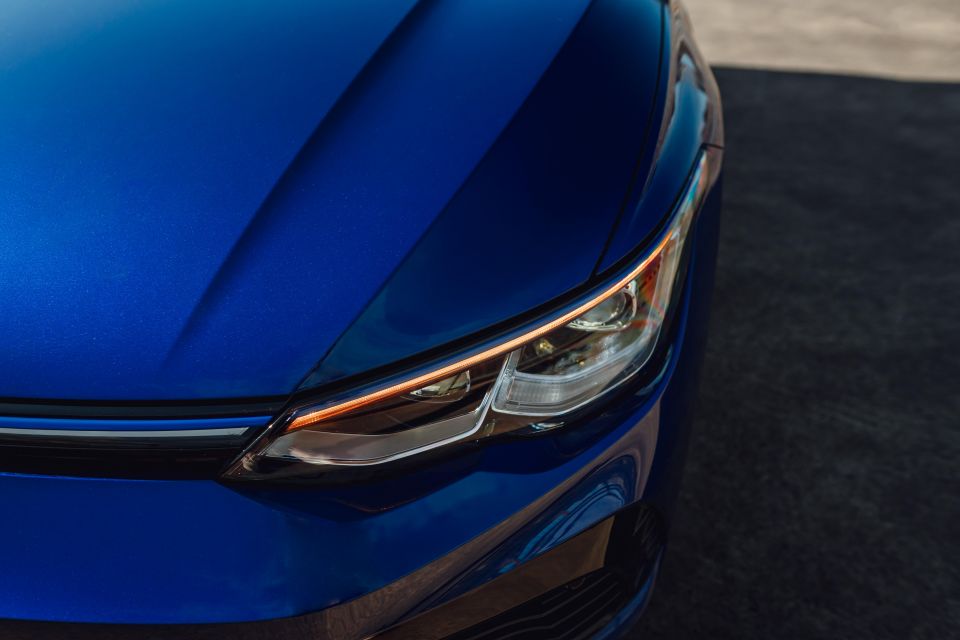
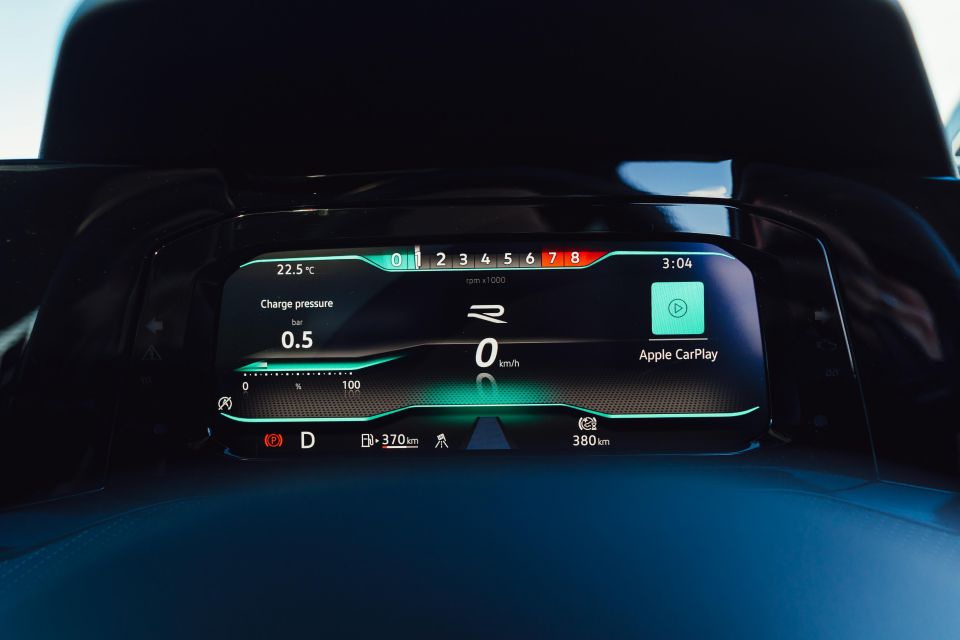
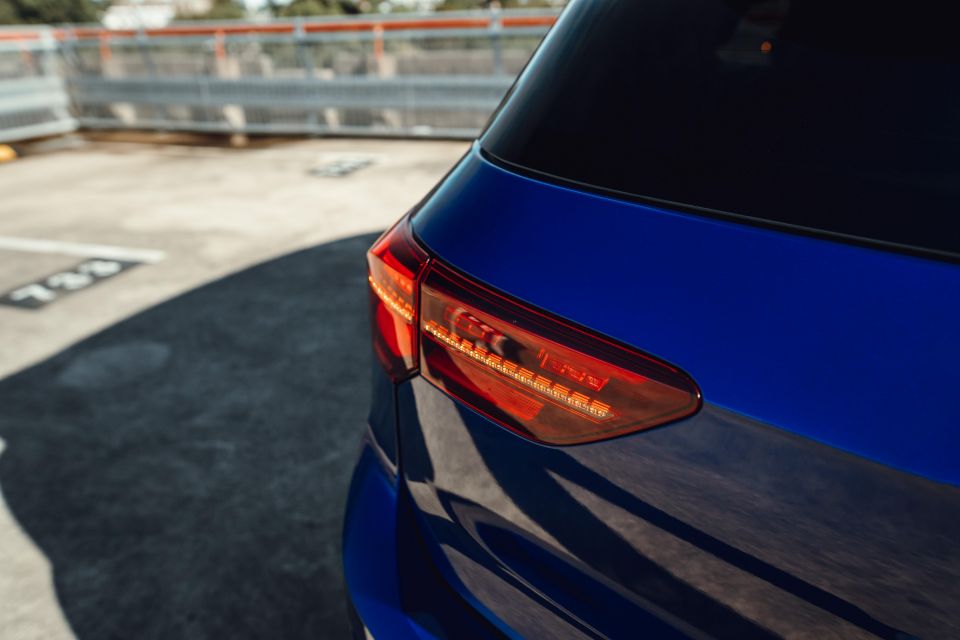

Golf R highlights:
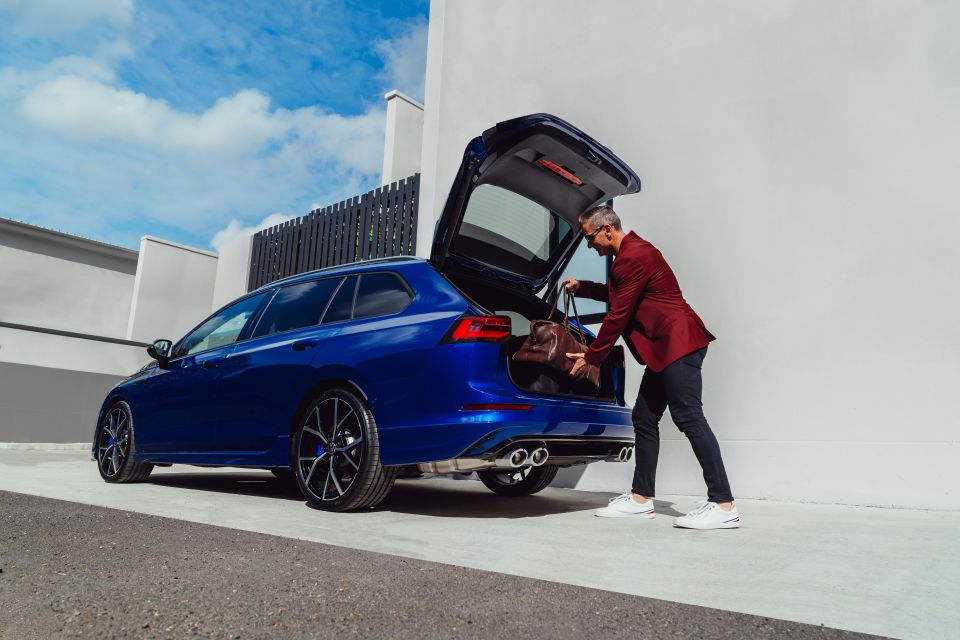
Golf R Wagon adds:
Options include:
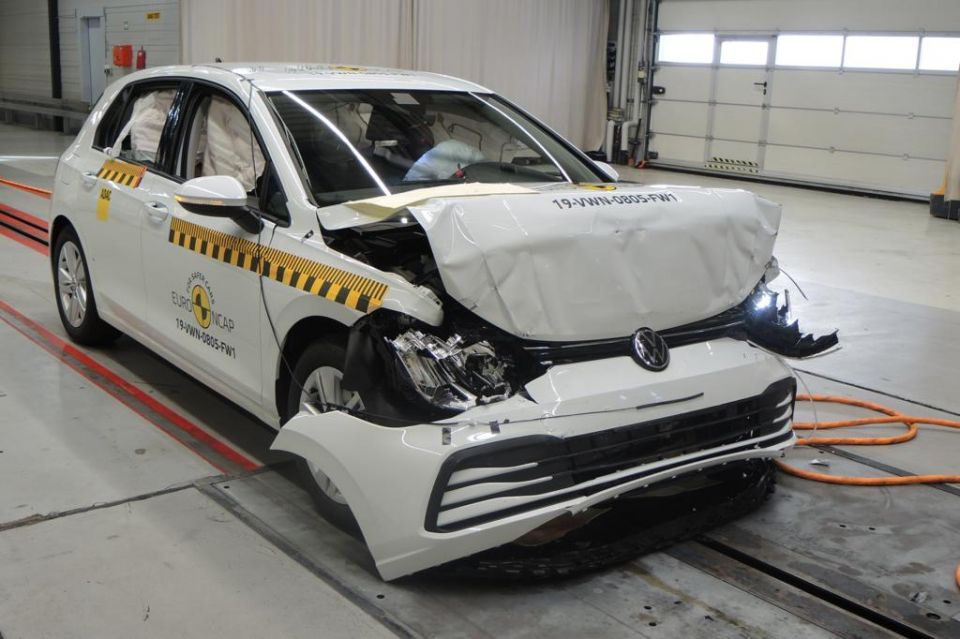
All versions of the Mk8 Volkswagen Golf wear a five-star ANCAP safety rating based on Euro NCAP testing in 2019.
It achieved 95 per cent for adult occupant protection, 89 per cent for child occupant protection, 76 per cent for vulnerable road user protection and 80 per cent for safety assist.
Eight airbags are standard – including dual front, front-side, rear-side and side curtain airbags.
Standard assistance features include:
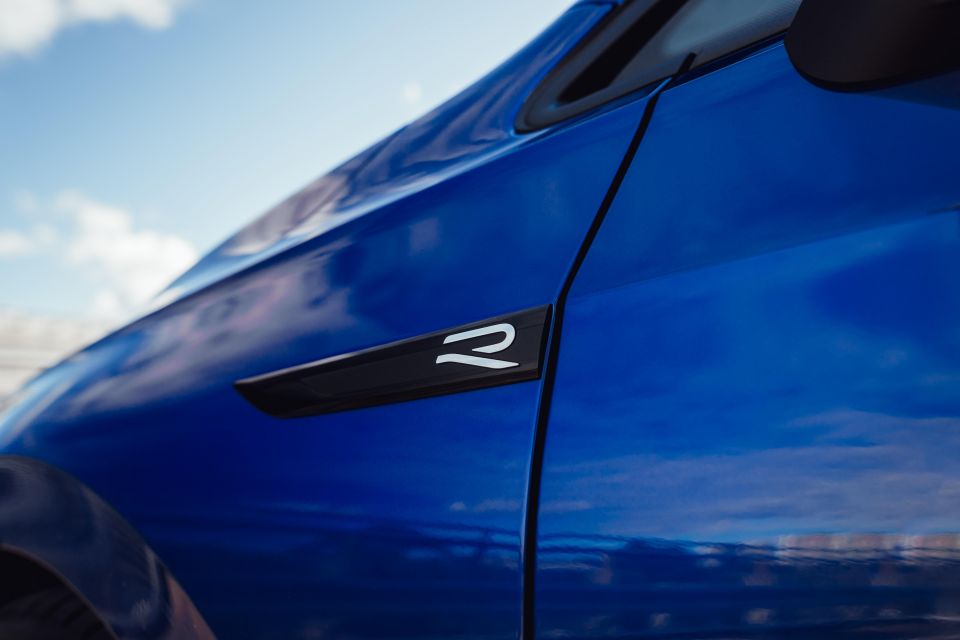
The Golf R, like the wider Volkswagen range, is covered by a five-year, unlimited-kilometre warranty.
One year of roadside assistance is thrown in at purchase, and if you service within the Volkswagen dealer network you’ll get an additional 12 months of roadside assistance for up to 10 years after the original new vehicle warranty start date.
Scheduled maintenance is required every 12 months or 15,000 kilometres, whichever comes first.
Volkswagen offers a five-year Care Plan, which for the Golf R range is priced at $3000 – nearly $500 more than luxury arm Audi charges for a five-year Care Plan for the related S3. The company claims the package saves $833 compared to servicing as you go. A three-year plan is also available for $1700.
As for real-world fuel consumption, we averaged an indicated 9.1L/100km over a 120km test loop which included the drive out to Kinglake and back to our Melbourne office, covering a mix of pretty spirited B-road driving, highway, freeway and urban environments.
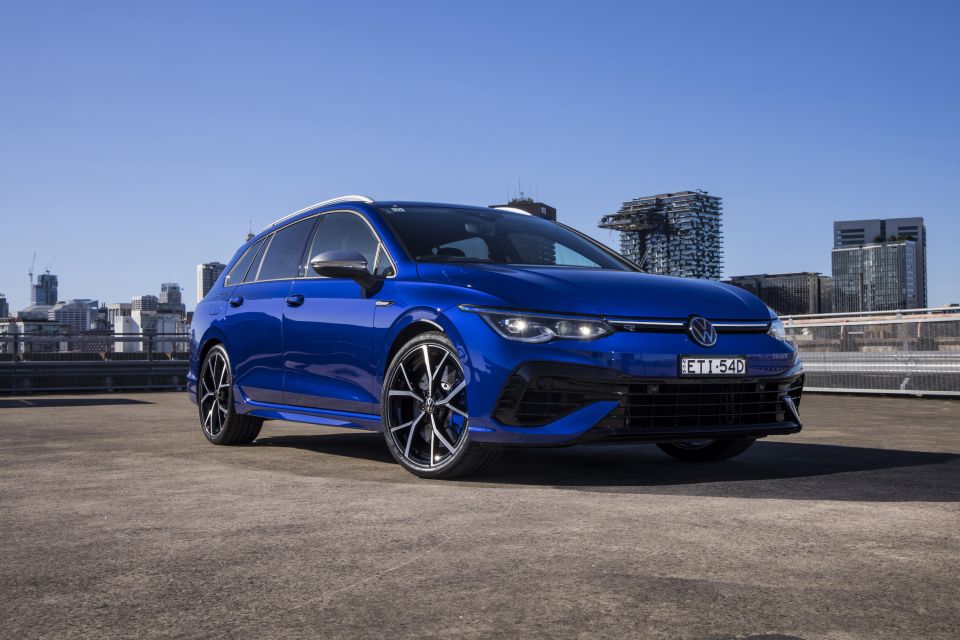
Volkswagen’s latest hot wagon has me a little torn.
I nearly bought a Mk7.5 R Wagon when I bought my GTI, as the long-bodied hot Golf added an extra dimension of practicality and cool factor to an already accomplished all-round package.
This new one, with its much higher pricing and some fiddly interior, isn’t quite the straight-bat success I feel its predecessor was.
Don’t get me wrong, the Mk8 Golf R Wagon is an impressive bit of kit – it’s stupid quick, has all the luxury and assistance features you’d expect of a car costing twice the price, and it’s meaningfully more practical than its hatchback sibling, and also more so in some ways over the identically-priced Tiguan R.
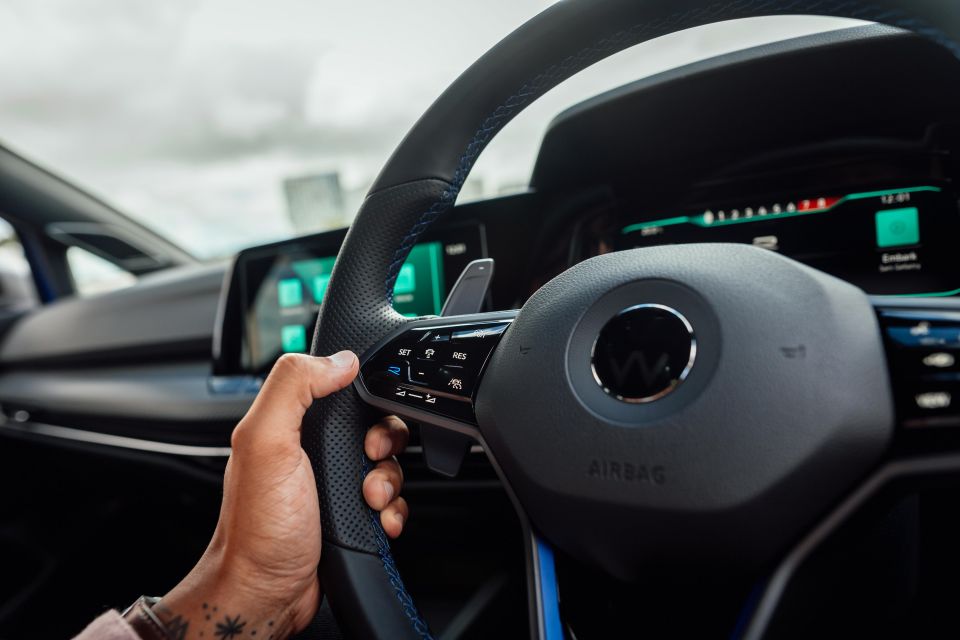
But $70,000 is a lot of money to pay for a Golf (which starts around the $30,000 mark), and doesn’t really do much to elevate the ambience in terms of materials and trimmings. Yes there’s R-specific appointments, but its more budget-conscious elements are more evident than say, the Mk7 and Mk7.5.
It’s dangerously close in price to the Audi S3 Sportback ($70,700) and S3 Sedan ($73,200), which offer essentially the same drivetrain minus the rear-axle torque vectoring and a smidgen less power and space, but the premium-badged cousins make up for it with superior cabin presentation and usability.
The limited personalisation options aren’t my cup of tea either. With just Lapiz Blue, Deep Black and Pure White on offer, both the Golf R and Golf R Wagon run the risk of losing their lustre if everyone goes for basically identical specs.
If your heart is set on a wagon, though, nothing in this price bracket comes close to offering the balance of performance and practicality the Golf R Wagon does. Sure, it ain’t perfect, but it’s still pretty damn impressive.

Click the images for the full gallery
Where expert car reviews meet expert car buying – CarExpert gives you trusted advice, personalised service and real savings on your next new car.
James Wong is an automotive journalist and former PR consultant, recognised among Australia’s most prolific motoring writers.


William Stopford
16 Hours Ago


Damion Smy
5 Days Ago
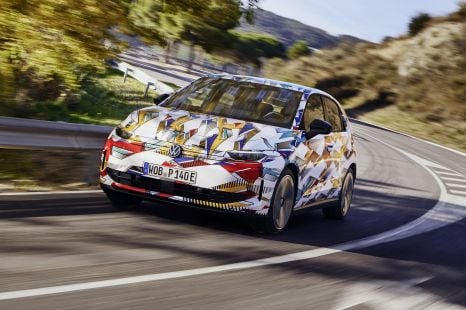

William Stopford
12 Days Ago
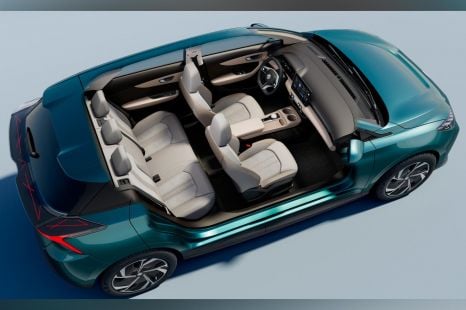

William Stopford
13 Days Ago
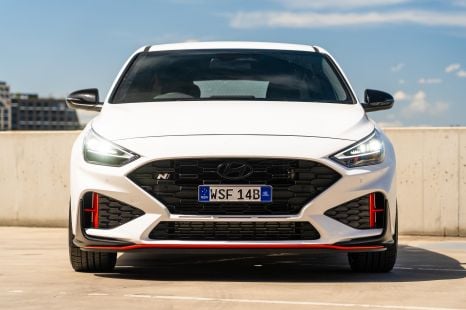

William Stopford
19 Days Ago
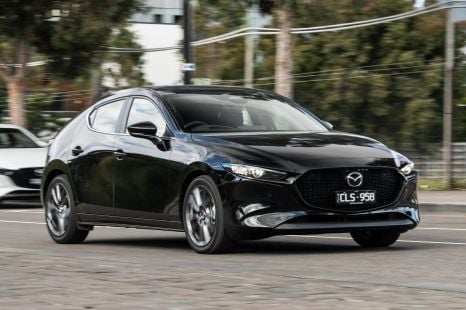

Josh Nevett
28 Days Ago